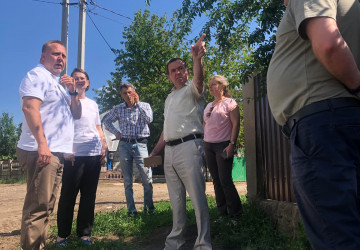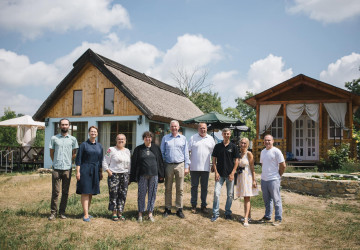Project ",,Ecosystem-based adaptation, climate-resilience measures and institutional development in the Lower Dniester”" implemented by BIOTICA Ecological Society and EcoContact funded by the Austrian Development Agency.
BIOTICA Ecological Society in partnership with PA EcoContact implement the project ,,Ecosystem-based adaptation, climate-resilience measures and institutional development in the Lower Dniester” with financial support of the Austrian Development Agency. Project Period: December 1st, 2017 – November 30th, 2021
Project Outcome: The long-term functionality of the Lower Dniester Ramsar Site is secured through improved conditions for its protection, enhanced ecosystem services and climate resilient livelihoods of the population.
Output 1. Implemented climate adaptation measures for water supply systems in villages from the LDRS, ensuring equal and affordable access to water for women, men and social vulnerable groups.
Output 3. Developed capacities of local communities from target area of the Lower Dniester for climate adaptation, nature conservation and management.
Output 4. Improved management of the Lower Dniester Ramsar Site through cost-based evaluation, biodiversity conservation and climate adaptation measures
Output 5. Selected areas of the LDRS are rehabilitated through forestation on both river banks. Ecosystem services and climate mitigation are enhanced.
All planned activities are being implemented according to the project timetable and requirements of legislation in force, including ecological one. All activities are conducted by experienced entities selected on tender basis.
In the frame of the Output 1 the Feasibility study of water supply / sanitation systems in Cioburciu, Copanca, Palanca and Plop-Stiubey Villages were conducted in February-July 2018 in order to identify the current situation and the necessary future steps to improve water systems. These studies were presented in each locality, attended by local population representatives.
Some priority measures to be done in water supply systems were selected for each of the villages (Cioburciu, Copanca, Palanca) based on these feasibility studies, together with the local public authorities. At the same time, some activities have been selected to be implemented in the villages of Talmaza and Popeasca on the basis of studies carried out in the previous project funded by ADA.
In July-October in the village of Cioburciu the reconstruction and extension of a part of water supply system with a length of 3300 has been done, which has improved the access to water to more than 100 households, the kindergarten and several shops in the area. A water tank in the same locality that is in a very bad condition is to be rebuilt and needs to be replaced to provide access to quality water for the local population.
The works for replacing two water reservoirs in Talmaza village started in November on the basis of elaborated technical projects and ended in April 2019.
The official inauguration of a new water reservoir with the capacity of 50 m.c. in Talmaza village water supply system took place On April 9, 2019.
More than 7,000 people have obtained better quality drinking water with a higher pressure as the result of the construction of the new water reservoir. The works were done in the frame of the project "Ecosystem-based adaptation, climate-resilience measures and institutional development in the Lower Dniester” project" due to the financial contribution of the Austrian Development Agency and Talmaza Mayoralty.
In the frame of the Output 4, as it was planned, databasing of forests / plantations and grassland areas was done basing on major species that forms ecosystem productivity, age (forest) and pasture digression in order to use for monetary evaluation of ecosystem services. For that, fragmentation of natural vegetation and some other ecosystem was also assessed. Biodiversity values were ranked for core areas and other discrete natural and subnatural areas. Biodiversity studies in certain areas and the bird monitoring are started. Also two tourist routes in Talmaza and Cioburciu were arranged and presented to the public.
In the frame of the Output 5, the areas to be afforested on the right bank of the Dniester was selected, for them technological charts were developed. The selected entity prepared the areas with a surface of 15 ha in Popeasca and conducted partly the forestation works. On November 17 2018, after a proper preparation of the land, with the help of over 200 volunteers and representatives of the Diplomatic Missions, as well as the European Development Agencies, the last 4 hectares of the 15 ha were planted.

























